axle SSANGYONG MUSSO 2003 Service Manual
[x] Cancel search | Manufacturer: SSANGYONG, Model Year: 2003, Model line: MUSSO, Model: SSANGYONG MUSSO 2003Pages: 1574, PDF Size: 26.41 MB
Page 1 of 1574
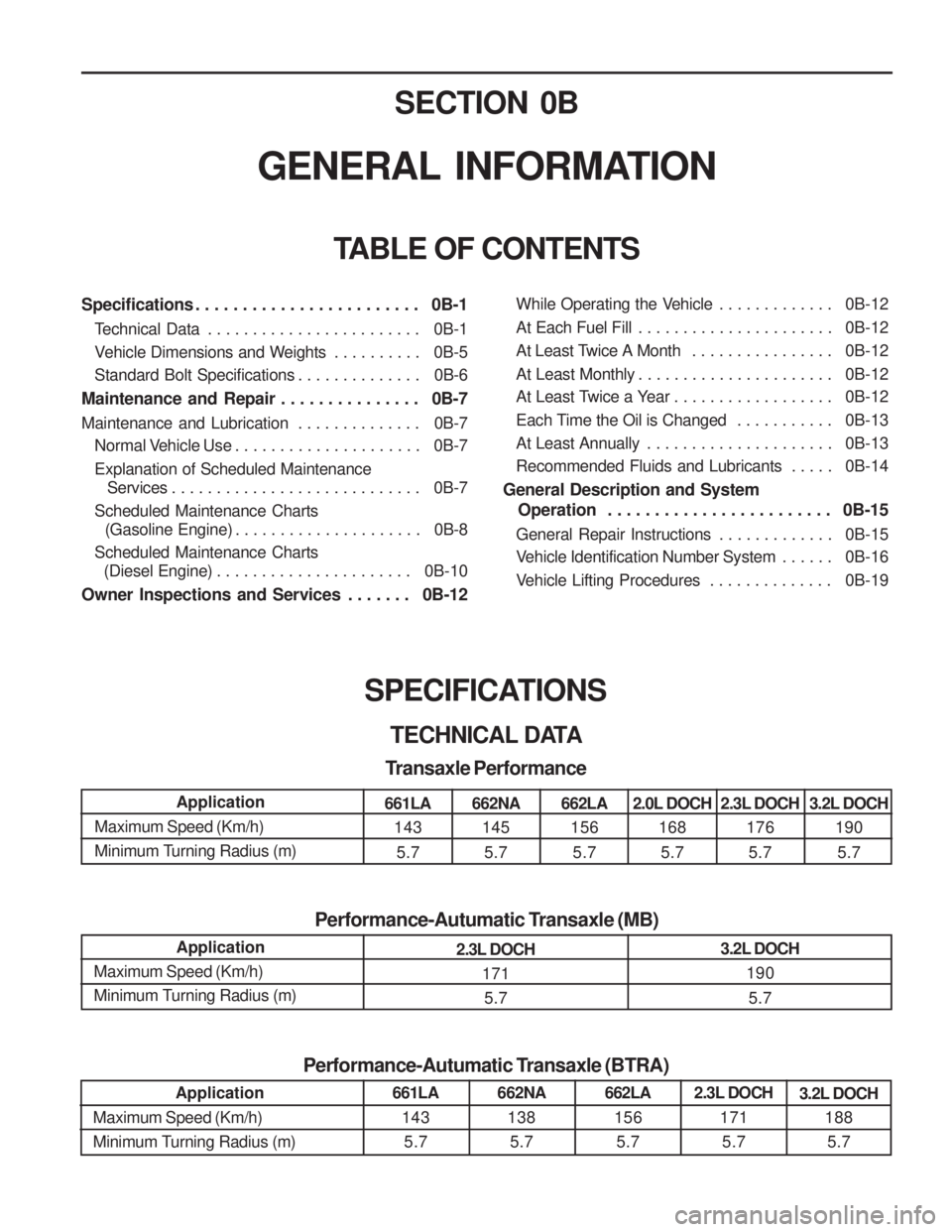
SECTION 0B
GENERAL INFORMATION
Specifications . . . . . . . . . . . . . . . . . . . . . . . . 0B-1Technical Data . . . . . . . . . . . . . . . . . . . . . . . . 0B-1
Vehicle Dimensions and Weights . . . . . . . . . . 0B-5
Standard Bolt Specifications . . . . . . . . . . . . . . 0B-6
Maintenance and Repair . . . . . . . . . . . . . . . 0B-7
Maintenance and Lubrication . . . . . . . . . . . . . . 0B-7 Normal Vehicle Use . . . . . . . . . . . . . . . . . . . . . 0B-7 Explanation of Scheduled Maintenance
Services . . . . . . . . . . . . . . . . . . . . . . . . . . . . 0B-7
Scheduled Maintenance Charts
(Gasoline Engine) . . . . . . . . . . . . . . . . . . . . . 0B-8 Scheduled Maintenance Charts
(Diesel Engine) . . . . . . . . . . . . . . . . . . . . . . 0B-10
Owner Inspections and Services . . . . . . . 0B-12 TABLE OF CONTENTS
While Operating the Vehicle . . . . . . . . . . . . . 0B-12
At Each Fuel Fill . . . . . . . . . . . . . . . . . . . . . . 0B-12
At Least Twice A Month . . . . . . . . . . . . . . . . 0B-12
At Least Monthly . . . . . . . . . . . . . . . . . . . . . . 0B-12
At Least Twice a Year . . . . . . . . . . . . . . . . . . 0B-12
Each Time the Oil is Changed . . . . . . . . . . . 0B-13
At Least Annually . . . . . . . . . . . . . . . . . . . . . 0B-13
Recommended Fluids and Lubricants . . . . . 0B-14
General Description and System
Operation . . . . . . . . . . . . . . . . . . . . . . . . 0B-15
General Repair Instructions . . . . . . . . . . . . . 0B-15
Vehicle Identification Number System . . . . . . 0B-16
Vehicle Lifting Procedures . . . . . . . . . . . . . . 0B-19
SPECIFICATIONS TECHNICAL DATA
Transaxle Performance
Application
Maximum Speed (Km/h)
Minimum Turning Radius (m)
661LA 143
5.7662NA 145
5.7 662LA
156
5.7 2.0L DOCH
168
5.7 2.3L DOCH
176
5.7 3.2L DOCH
190
5.7
Application
Maximum Speed (Km/h)
Minimum Turning Radius (m)
Performance-Autumatic Transaxle (MB)
2.3L DOCH171
5.7 3.2L DOCH
190
5.7
Application
Maximum Speed (Km/h)
Minimum Turning Radius (m)
Performance-Autumatic Transaxle (BTRA)
661LA1435.7 662NA
1385.7 662LA
1565.7 2.3L DOCH
1715.7 3.2L DOCH
1885.7
Page 9 of 1574
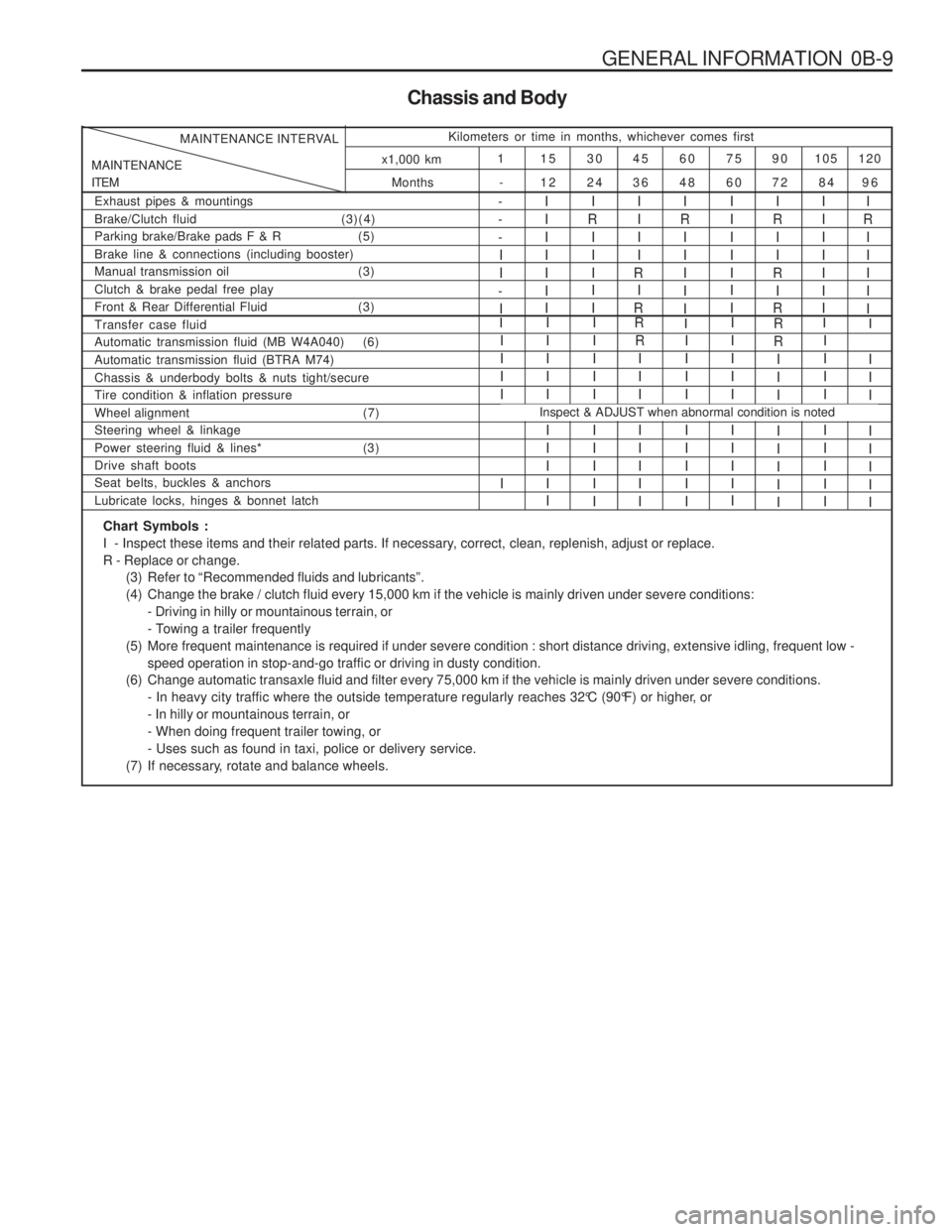
GENERAL INFORMATION 0B-9
Chassis and Body
Months
MAINTENANCE ITEM MAINTENANCE INTERVAL
Kilometers or time in months, whichever comes first
120
105
90
75
60
45
30
15
1
96
84
72
60
48
36
24
12
-
x1,000 km
Exhaust pipes & mountings Brake/Clutch fluid
(3)(4)
Parking brake/Brake pads F & R (5)Brake line & connections (including booster)
Manual transmission oil (3) Clutch & brake pedal free play
Front & Rear Differential Fluid (3)I
R
IIIII- --II
-
I IIIIII I
I
R I II I I IIII
R I
R IIIII I II
R
II
R I
R IIIIII II
R I IIII
Automatic transmission fluid (MB W4A040) (6) Automatic transmission fluid (BTRA M74)Chassis & underbody bolts & nuts tight/secure Tire condition & inflation pressure
Wheel alignment (7) Steering wheel & linkage
Power steering fluid & lines* (3)Drive shaft boots Seat belts, buckles & anchors Lubricate locks, hinges & bonnet latchIIII I I IIII I III I I IIII I IIII
R
III I IIII IIII I IIIIIIIII I III I
R R
III I IIII IIII I IIII
Transfer case fluidRII
I
Inspect & ADJUST when abnormal condition is noted
I
I II I IIII
Chart Symbols :
I - Inspect these items and their related parts. If necessary, correct, clean, replenish, adjust or replace.R - Replace or change.
(3) Refer to “Recommended fluids and lubricants”.
(4) Change the brake / clutch fluid every 15,000 km if the vehicle is mainly driven under severe conditions:- Driving in hilly or mountainous terrain, or
- Towing a trailer frequently
(5) More frequent maintenance is required if under severe condition : short distance driving, extensive idling, frequent low - speed operation in stop-and-go traffic or driving in dusty condition.
(6) Change automatic transaxle fluid and filter every 75,000 km if the vehicle is mainly driven under severe conditions. - In heavy city traffic where the outside temperature regularly reaches 32°C (90°F) or higher, or- In hilly or mountainous terrain, or- When doing frequent trailer towing, or- Uses such as found in taxi, police or delivery service.
(7) If necessary, rotate and balance wheels.
Page 13 of 1574
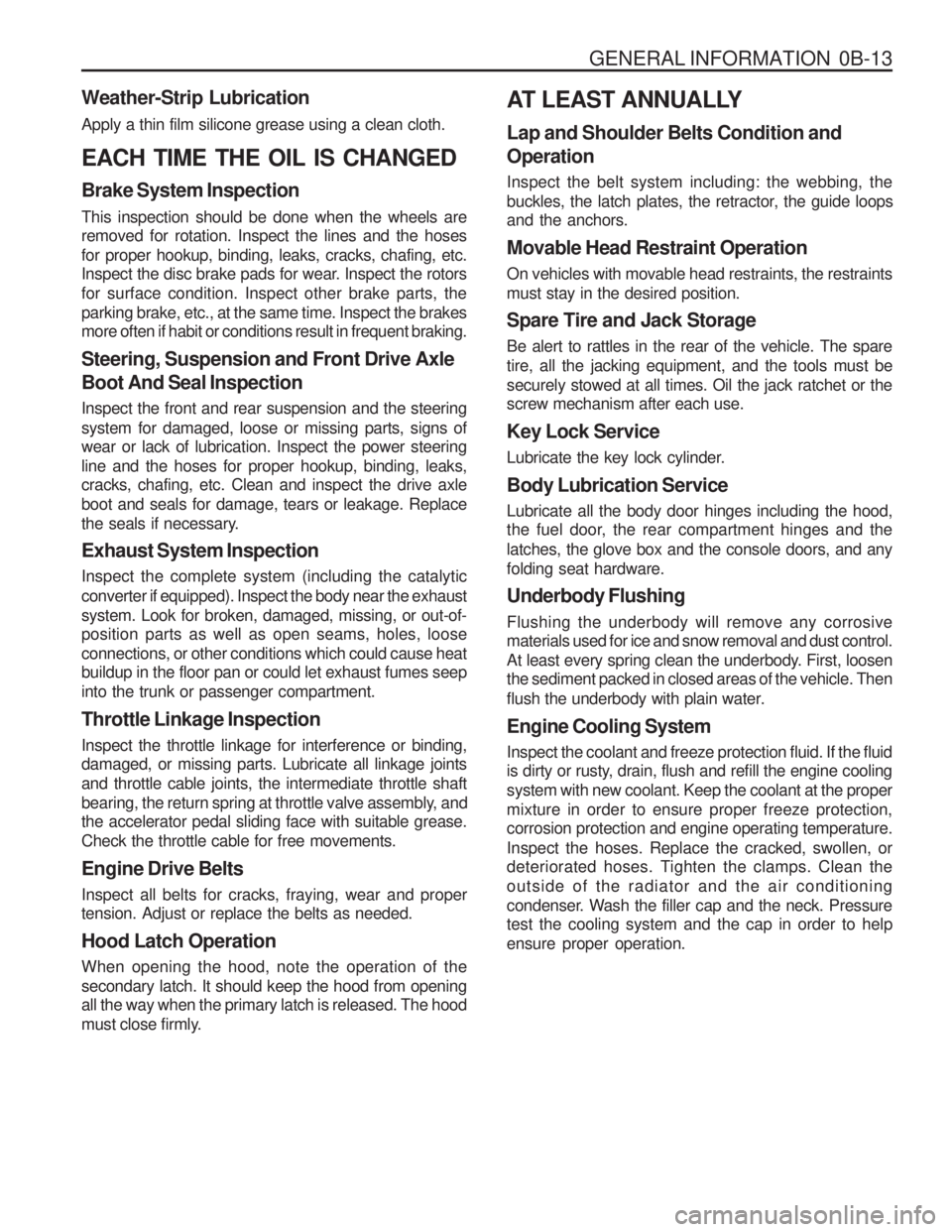
GENERAL INFORMATION 0B-13
Weather-Strip Lubrication Apply a thin film silicone grease using a clean cloth. EACH TIME THE OIL IS CHANGED Brake System Inspection This inspection should be done when the wheels are removed for rotation. Inspect the lines and the hoses for proper hookup, binding, leaks, cracks, chafing, etc.
Inspect the disc brake pads for wear. Inspect the rotors for surface condition. Inspect other brake parts, theparking brake, etc., at the same time. Inspect the brakes more often if habit or conditions result in frequent braking. Steering, Suspension and Front Drive Axle Boot And Seal Inspection Inspect the front and rear suspension and the steering system for damaged, loose or missing parts, signs of wear or lack of lubrication. Inspect the power steering line and the hoses for proper hookup, binding, leaks, cracks, chafing, etc. Clean and inspect the drive axle boot and seals for damage, tears or leakage. Replace
the seals if necessary. Exhaust System Inspection Inspect the complete system (including the catalytic converter if equipped). Inspect the body near the exhaustsystem. Look for broken, damaged, missing, or out-of- position parts as well as open seams, holes, loose connections, or other conditions which could cause heat buildup in the floor pan or could let exhaust fumes seep into the trunk or passenger compartment. Throttle Linkage Inspection Inspect the throttle linkage for interference or binding, damaged, or missing parts. Lubricate all linkage joints and throttle cable joints, the intermediate throttle shaft
bearing, the return spring at throttle valve assembly, and the accelerator pedal sliding face with suitable grease. Check the throttle cable for free movements. Engine Drive Belts Inspect all belts for cracks, fraying, wear and proper tension. Adjust or replace the belts as needed. Hood Latch Operation When opening the hood, note the operation of the secondary latch. It should keep the hood from opening all the way when the primary latch is released. The hood
must close firmly. AT LEAST ANNUALLY Lap and Shoulder Belts Condition and Operation Inspect the belt system including: the webbing, the
buckles, the latch plates, the retractor, the guide loops and the anchors. Movable Head Restraint Operation On vehicles with movable head restraints, the restraints must stay in the desired position. Spare Tire and Jack Storage Be alert to rattles in the rear of the vehicle. The spare tire, all the jacking equipment, and the tools must besecurely stowed at all times. Oil the jack ratchet or the screw mechanism after each use. Key Lock Service
Lubricate the key lock cylinder. Body Lubrication Service Lubricate all the body door hinges including the hood,
the fuel door, the rear compartment hinges and the latches, the glove box and the console doors, and anyfolding seat hardware. Underbody Flushing Flushing the underbody will remove any corrosive materials used for ice and snow removal and dust control.
At least every spring clean the underbody. First, loosen the sediment packed in closed areas of the vehicle. Then
flush the underbody with plain water. Engine Cooling System Inspect the coolant and freeze protection fluid. If the fluid
is dirty or rusty, drain, flush and refill the engine cooling system with new coolant. Keep the coolant at the propermixture in order to ensure proper freeze protection, corrosion protection and engine operating temperature. Inspect the hoses. Replace the cracked, swollen, or
deteriorated hoses. Tighten the clamps. Clean the outside of the radiator and the air conditioning
condenser. Wash the filler cap and the neck. Pressure test the cooling system and the cap in order to help ensure proper operation.
Page 50 of 1574
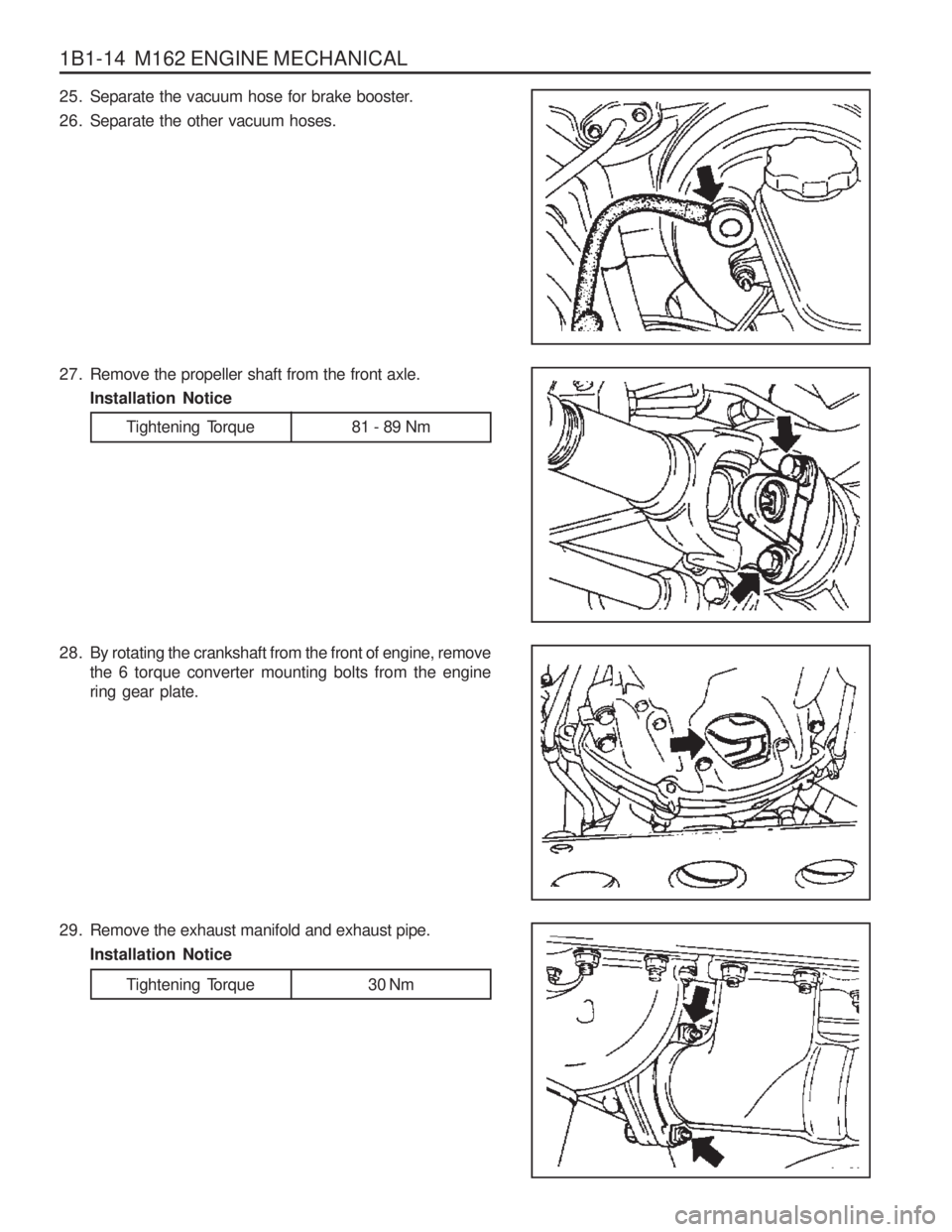
1B1-14 M162 ENGINE MECHANICAL
Tightening Torque 30 Nm
29. Remove the exhaust manifold and exhaust pipe.
Installation Notice
25. Separate the vacuum hose for brake booster.
26. Separate the other vacuum hoses.
27. Remove the propeller shaft from the front axle.Installation Notice
28. By rotating the crankshaft from the front of engine, remove the 6 torque converter mounting bolts from the engine ring gear plate.
Tightening Torque 81 - 89 Nm
Page 167 of 1574

M161 ENGINE MECHANICAL 1B2-15
Tightening Torque 30 Nm
29. Remove the exhaust manifold and exhaust pipe.
Installation Notice
25. Separate the vacuum hose for brake booster.
26. Separate the other vacuum hoses.
27. Remove the propeller shaft from the front axle.Installation Notice
28. By rotating the crankshaft from the front of engine, remove the 6 torque converter mounting bolts from the engine ring gear plate.
Tightening Torque 81 - 89 Nm
Page 267 of 1574

1B3-2 OM600 ENGINE MECHANICALSPECIFICATIONS
FASTENER TIGHTENING SPECIFICATIONS
N
m
28 - 47 30
3 - 7
8 - 18
20 - 34 30
70 - 80 81 - 8450 - 75
N
m
10 23
200 / 90 °
10
55 / 90 °
45 / 90 °
25 / 90 °
25
N
m
35 / 90 °
N
m
45 / 90 °
Application
Skid Plate Bolt Drain Plug Bolt Coolong Fan Shroud BoltControl Linkage NutClutch Linkage Cylinder NutExhaust Manifold Bolt
Propeller Shaft Bolt & Nut (Axle) Propeller Shaft Bolt & Nut (T/C)
Engine Mounting Nut
Application
Cooling Fan Belt Pulley Bolt Socket Bolt
Tighten The BoltEnd Cover BoltCrankshaft Bearing Cap Bolt Ball Bearing Camshaft Sprocket BoltOil Pump Sprocket Bolt
Application
Connecting Rod Bolt
Application
12-Sided Stretch Bolt
Engine Assembly
Crankshaft Assembly Piston
Flywheel
Cylinder Head
Application
Prechamber Threaded Ring Cylinder Head Cover Bolt Fuel Injsction Pipe NutSocket BoltFuel Filter Pipe BoltIdle Pulley Bolt Damper Bolt N
m
130 10 18252523 21
Page 284 of 1574

OM600 ENGINE MECHANICAL 1B3-19
33. Disconnect the exhaust pipe flange from the exhaustmanifold. Installation Notice
35. Remove the shift control cable.
36. Remove the transmission.
Tightening TorqueAxle 70 ~ 80 Nm T/C 81 ~ 89 Nm
Tightening Torque 20 - 34 Nm
31. Separate the exhaust pipe flange from the turbo charger.
Installation Notice
32. Loosen the installing bolt of clutch release cylinder and remove the clutch release cylinder. Installation Notice
Tightening Torque 30 Nm
Tightening Torque 30 Nm
34. Remove the propeller shaft from the transmission. Installation Notice
Page 699 of 1574
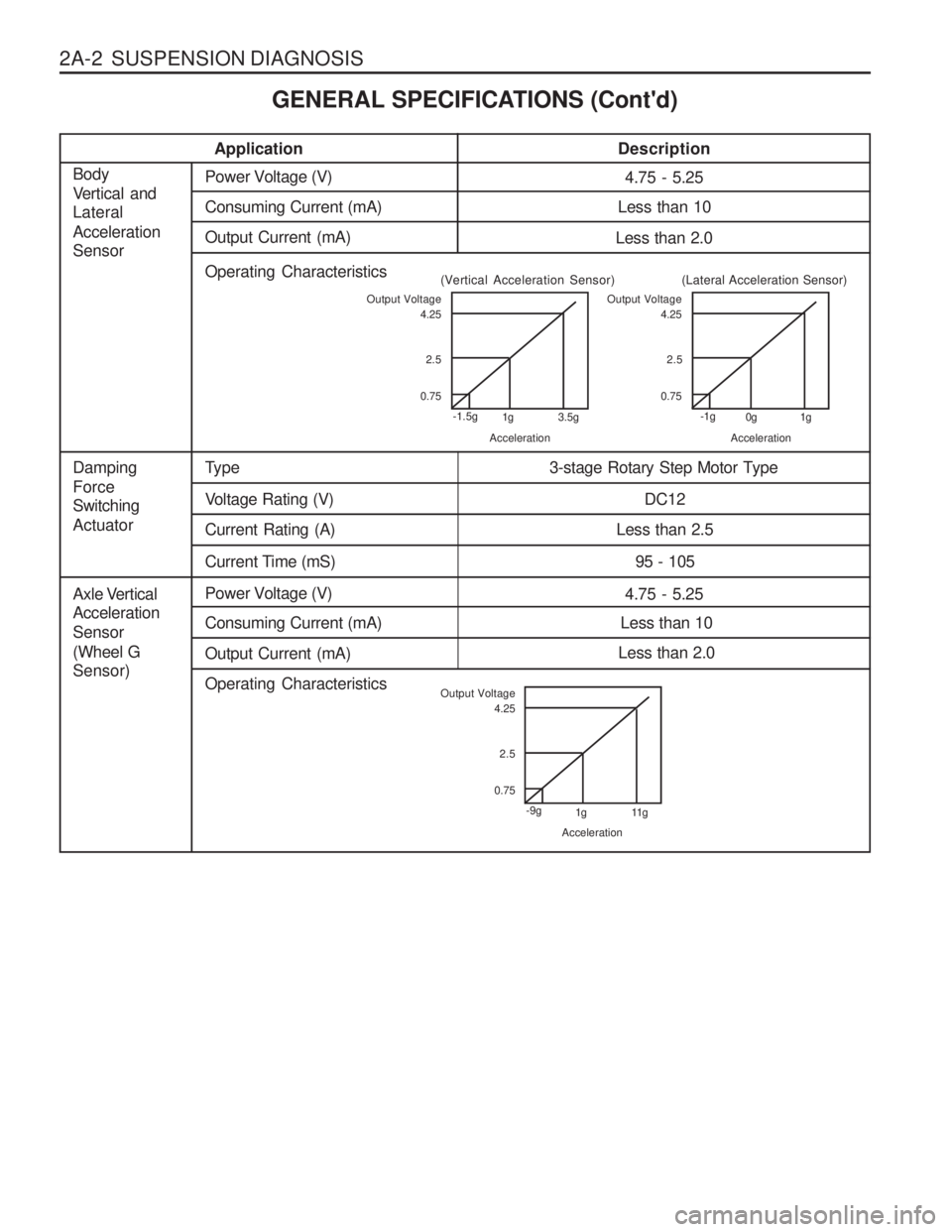
2A-2 SUSPENSION DIAGNOSISApplication
Description
4.75 - 5.25Power Voltage (V)
Axle Vertical Acceleration Sensor(Wheel G Sensor) Less than 10
Consuming Current (mA)
Less than 2.0
Output Current (mA)
Operating Characteristics
Type
Damping Force Switching Actuator3-stage Rotary Step Motor Type
Voltage Rating (V)
DC12
Current Rating (A)
Less than 2.5
Current Time (mS) 95 - 105
4.75 - 5.25Power Voltage (V)
Body
Vertical and Lateral Acceleration Sensor
Less than 10
Consuming Current (mA)
Less than 2.0
Output Current (mA)
Operating Characteristics
Output Voltage
0.752.5
4.25
-1.5g 1g 3.5g
Acceleration
(Vertical Acceleration Sensor)Output Voltage
0.752.5
4.25
-1g 0g 1g
Acceleration
(Lateral Acceleration Sensor)
Output Voltage
0.752.5
4.25
-9g 1g 11g
Acceleration
GENERAL SPECIFICATIONS (Cont'd)
Page 702 of 1574
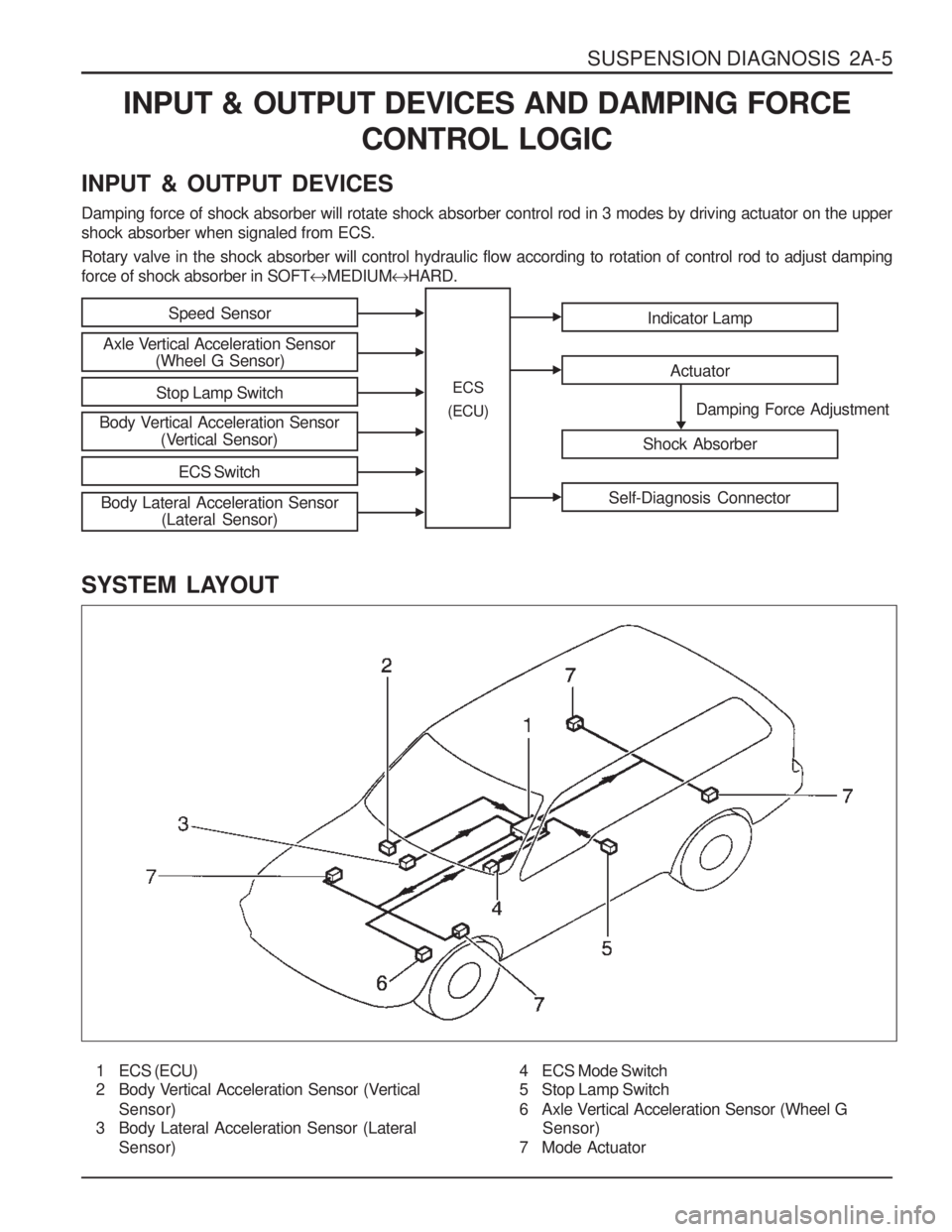
SUSPENSION DIAGNOSIS 2A-5
INPUT & OUTPUT DEVICES AND DAMPING FORCECONTROL LOGIC
INPUT & OUTPUT DEVICES Damping force of shock absorber will rotate shock absorber control rod in 3 modes by driving actuator on the upper shock absorber when signaled from ECS. Rotary valve in the shock absorber will control hydraulic flow according to rotation of control rod to adjust damping force of shock absorber in SOFT �MEDIUM �HARD.
SYSTEM LAYOUT
1 ECS (ECU)
2 Body Vertical Acceleration Sensor (Vertical Sensor)
3 Body Lateral Acceleration Sensor (Lateral
Sensor)
Speed Sensor
Axle Vertical Acceleration Sensor (Wheel G Sensor)
Stop Lamp Switch
Body Vertical Acceleration Sensor (Vertical Sensor)
ECS Switch
Indicator Lamp
Actuator
Shock Absorber
Self-Diagnosis Connector
Damping Force Adjustment
ECS
(ECU)
Body Lateral Acceleration Sensor (Lateral Sensor)
4 ECS Mode Switch
5 Stop Lamp Switch
6 Axle Vertical Acceleration Sensor (Wheel G
Sensor)
7 Mode Actuator
Page 703 of 1574
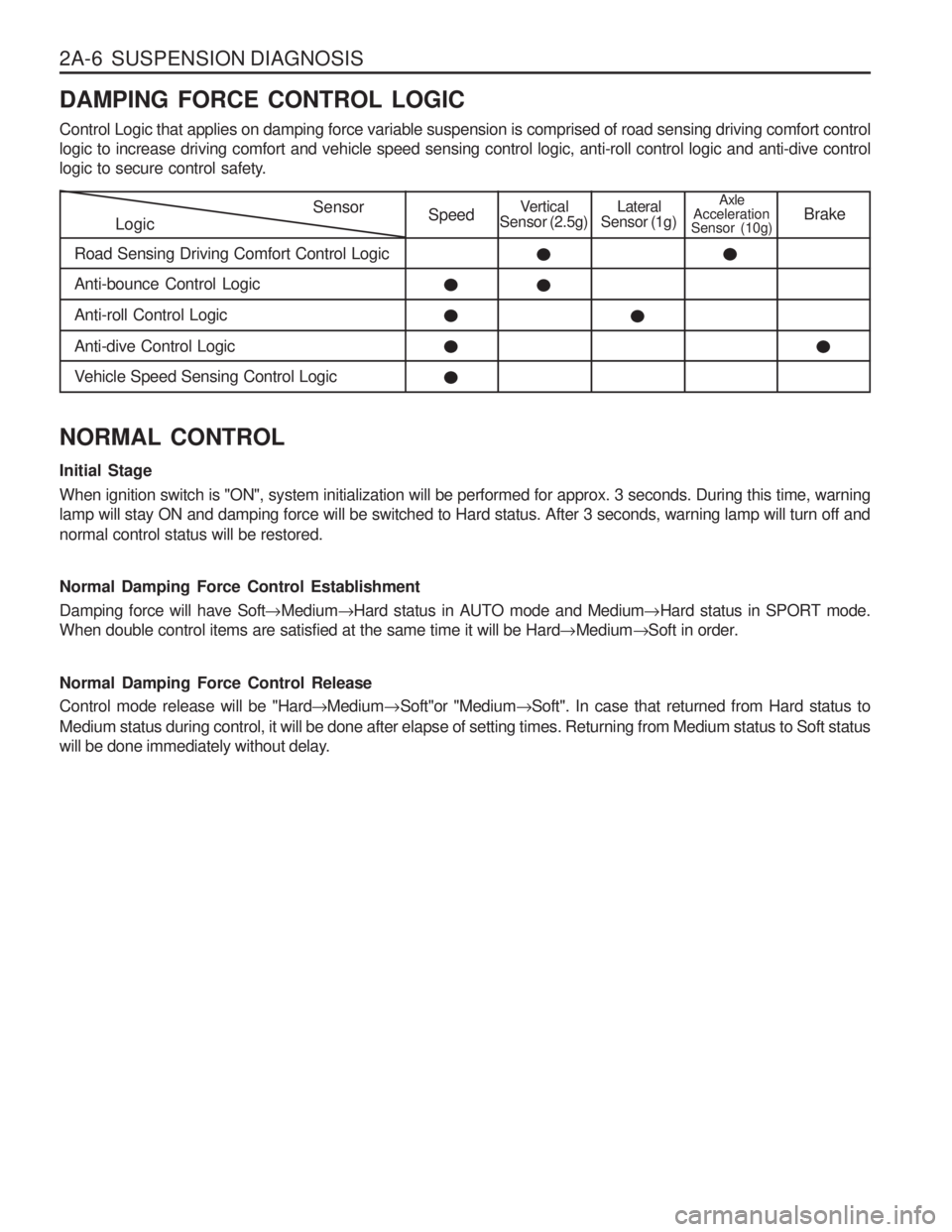
2A-6 SUSPENSION DIAGNOSIS DAMPING FORCE CONTROL LOGIC Control Logic that applies on damping force variable suspension is comprised of road sensing driving comfort control logic to increase driving comfort and vehicle speed sensing control logic, anti-roll control logic and anti-dive control
logic to secure control safety.
LogicSensor
Road Sensing Driving Comfort Control LogicSpeedVertical
Sensor (2.5g)Lateral
Sensor (1g)Axle
Acceleration
Sensor (10g) Brake
Anti-bounce Control Logic Anti-roll Control LogicAnti-dive Control Logic
Vehicle Speed Sensing Control Logic
NORMAL CONTROL Initial Stage When ignition switch is "ON", system initialization will be performed for approx. 3 seconds. During this time, warning lamp will stay ON and damping force will be switched to Hard status. After 3 seconds, warning lamp will turn off and normal control status will be restored. Normal Damping Force Control Establishment Damping force will have Soft �Medium �Hard status in AUTO mode and Medium �Hard status in SPORT mode.
When double control items are satisfied at the same time it will be Hard �Medium �Soft in order.
Normal Damping Force Control Release Control mode release will be "Hard �Medium �Soft"or "Medium �Soft". In case that returned from Hard status to
Medium status during control, it will be done after elapse of setting times. Returning from Medium status to Soft status
will be done immediately without delay.